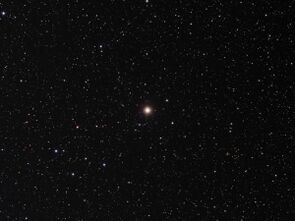Astronomy:Beta Lacertae
| Observation data Equinox J2000.0]] (ICRS) | |
|---|---|
| Constellation | Lacerta |
| Right ascension | 22h 23m 33.624s[1] |
| Declination | +52° 13′ 44.56″[1] |
| Apparent magnitude (V) | 4.43[2] |
| Characteristics | |
| Spectral type | G8 III[3] |
| U−B color index | +0.77[4] |
| B−V color index | +1.02[4] |
| V−R color index | 0.6[2] |
| R−I color index | +0.57[4] |
| Astrometry | |
| Radial velocity (Rv) | −10.4 ± 0.9[2] km/s |
| Proper motion (μ) | RA: −13.25±0.13[1] mas/yr Dec.: −186.77±0.13[1] mas/yr |
| Parallax (π) | 19.19 ± 0.16[1] mas |
| Distance | 170 ± 1 ly (52.1 ± 0.4 pc) |
| Absolute magnitude (MV) | +0.67[5] |
| Details[5] | |
| Mass | 0.97±0.21[3] M☉ |
| Radius | 10.96±0.23[3] R☉ |
| Luminosity | 57.7±3.0[3] L☉ |
| Surface gravity (log g) | 2.43 cgs |
| Temperature | 4803±75[3] K |
| Metallicity [Fe/H] | −0.33 dex |
| Rotational velocity (v sin i) | < 17[4] km/s |
| Age | 6.76±3.59[3] Gyr |
| Other designations | |
| Database references | |
| SIMBAD | data |
Beta Lacertae (Beta Lac, β Lacertae, β Lac) is the fourth-brightest star in the constellation of Lacerta. Based upon an annual parallax shift of 19.19 mas,[1] it is 170 light-years distant from Earth. At that distance, the visual magnitude is diminished by an extinction factor of 0.17 due to interstellar dust.[5]
This is an evolved G-type giant with an apparent visual magnitude of approximately 4.43.[2] It is a red clump[6] star and the primary component of a suspected binary system, with the pair having an angular separation of 0.2 arcsecond.[7]
Naming
In Chinese, 螣蛇 (Téng Shé), meaning Flying Serpent, refers to an asterism consisting of β Lacertae, α Lacertae, 4 Lacertae, π2 Cygni, π1 Cygni, HD 206267, ε Cephei, σ Cassiopeiae, ρ Cassiopeiae, τ Cassiopeiae, AR Cassiopeiae, 9 Lacertae, 3 Andromedae, 7 Andromedae, 8 Andromedae, λ Andromedae, κ Andromedae, ι Andromedae and ψ Andromedae. Consequently, the Chinese name for β Lacertae itself is 螣蛇十 (Téng Shé shí, English: the Tenth Star of Flying Serpent).[8]
References
- ↑ 1.0 1.1 1.2 1.3 1.4 1.5 van Leeuwen, F. (2007). "Validation of the new Hipparcos reduction". Astronomy and Astrophysics 474 (2): 653–664. doi:10.1051/0004-6361:20078357. Bibcode: 2007A&A...474..653V. http://www.aanda.org/articles/aa/full/2007/41/aa8357-07/aa8357-07.html.Vizier catalog entry
- ↑ 2.0 2.1 2.2 2.3 2.4 "bet Lac". SIMBAD. Centre de données astronomiques de Strasbourg. http://simbad.u-strasbg.fr/simbad/sim-basic?Ident=bet+Lac.
- ↑ 3.0 3.1 3.2 3.3 3.4 3.5 Baines, Ellyn K. et al. (2018). "Fundamental Parameters of 87 Stars from the Navy Precision Optical Interferometer". The Astronomical Journal 155 (1): 30. doi:10.3847/1538-3881/aa9d8b. Bibcode: 2018AJ....155...30B.
- ↑ 4.0 4.1 4.2 4.3 HR 8538, database entry, The Bright Star Catalogue, 5th Revised Ed. (Preliminary Version), D. Hoffleit and W. H. Warren, Jr., CDS ID V/50. Accessed on line November 17, 2008.
- ↑ 5.0 5.1 5.2 Takeda, Yoichi et al. (August 2008), "Stellar Parameters and Elemental Abundances of Late-G Giants", Publications of the Astronomical Society of Japan 60 (4): 781–802, doi:10.1093/pasj/60.4.781, Bibcode: 2008PASJ...60..781T.
- ↑ Mishenina, T. V. et al. (September 2006), "Elemental abundances in the atmosphere of clump giants", Astronomy and Astrophysics 456 (3): 1109–1120, doi:10.1051/0004-6361:20065141, Bibcode: 2006A&A...456.1109M.
- ↑ Eggleton, P. P.; Tokovinin, A. A. (September 2008), "A catalogue of multiplicity among bright stellar systems", Monthly Notices of the Royal Astronomical Society 389 (2): 869–879, doi:10.1111/j.1365-2966.2008.13596.x, Bibcode: 2008MNRAS.389..869E.
- ↑ (in Chinese) AEEA (Activities of Exhibition and Education in Astronomy) 天文教育資訊網 2006 年 7 月 7 日
 |


